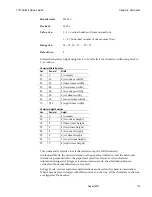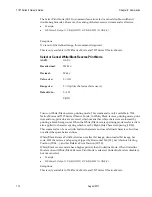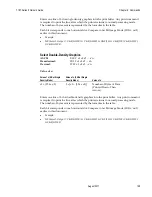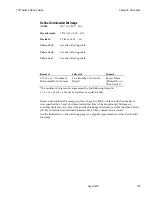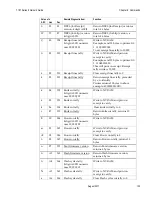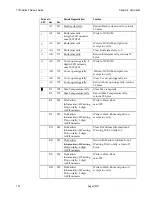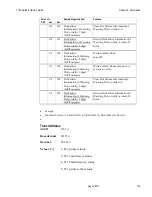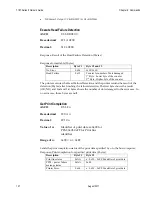
7197 Series II Owner’s Guide
Chapter 6: Commands
August
2011
126
Status Commands
Status Command Introduction
The 7197 Series II has three methods of providing status to the application. These methods
are through Batch Status Commands, Real Time Status Commands, and Auto Status Back.
An application may use one or more of these methods to understand the current status of
the printer. A brief description of each of these methods follows.
Batch Status Commands
– These commands are sent to the printer and stored in the
printer’s buffer. Once the printer has processed all the previous commands these
commands are processed and the proper status is returned to the application. In the event
a condition causes the printer to go BUSY, it stops processing commands from the printer
buffer. If a Batch Status Command remained in the buffer during this busy condition, it
would not be processed. In fact, no Batch Commands are processed while the printer is in
this state.
Real-Time Commands
– These commands are sent to the printer and are NOT stored in
the printer’s buffer. Instead, they are acted on immediately (regardless of the printer’s
BUSY status) and their response (if any) is returned to the application. This gives the
application the ability to query the printer when it is in a busy state in order to correct
whatever fault has occurred.
Auto Status Back
– This mechanism allows the application developer to program the
printer to automatically respond with a four byte status when certain conditions in the
printer change.
Please see the subsequent sections for a more detailed description of these status
commands. At the end of this Status Commands section is a page entitled “Recognizing
Data from the Printer”. This describes how to interpret what command or setting (in the
case of Auto Status Back) triggered a response from the printer.
Batch Mode
For RS-232C printers, these commands enable the printer to communicate with the host
computer following the selected handshaking protocol, either DTR/DSR or XON/XOFF.
They are stored in the printer's data buffer as they are received, and are handled by the
firmware in the order in which they are received.
When a fault occurs, the printer will go busy at the RS-232C interface and not respond to
any of the Batch Mode Printer Status commands. If the fault causing the busy condition
can be cleared, such as by loading paper, or letting the thermal print head cool down, the
printer will resume processing the data in its receive buffer.
Summary of Contents for 7197 II SERIES
Page 5: ...v EMC 100 240 1 5 0 8 50 60 24 2 3 3 125 NCR NCR EMC 360 NCR EMC A A...
Page 7: ...vii A NCR NCR NCR A...
Page 35: ...7197 Series II Owner s Manual Chapter 2 Setting Up and Using the Printer 21 September 2011...
Page 37: ...7197 Series II Owner s Manual Chapter 2 Setting Up and Using the Printer 23 September 2011...
Page 38: ...7197 Series II Owner s Manual Chapter 2 Setting Up and Using the Printer 24 September 2011...
Page 253: ...7197 Series II Owner s Guide Appendix B Print Characteristics 228 Februrary 2012 Code Page 932...
Page 272: ...7197 Series II Owner s Guide Appendix B Print Characteristics 247 Februrary 2012...

